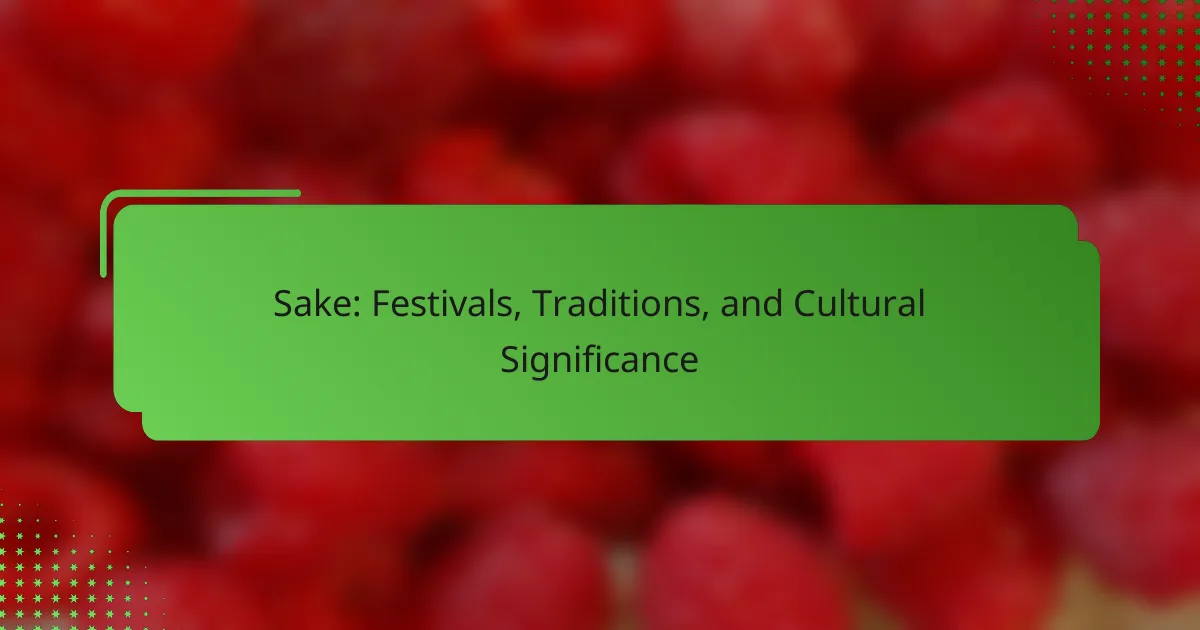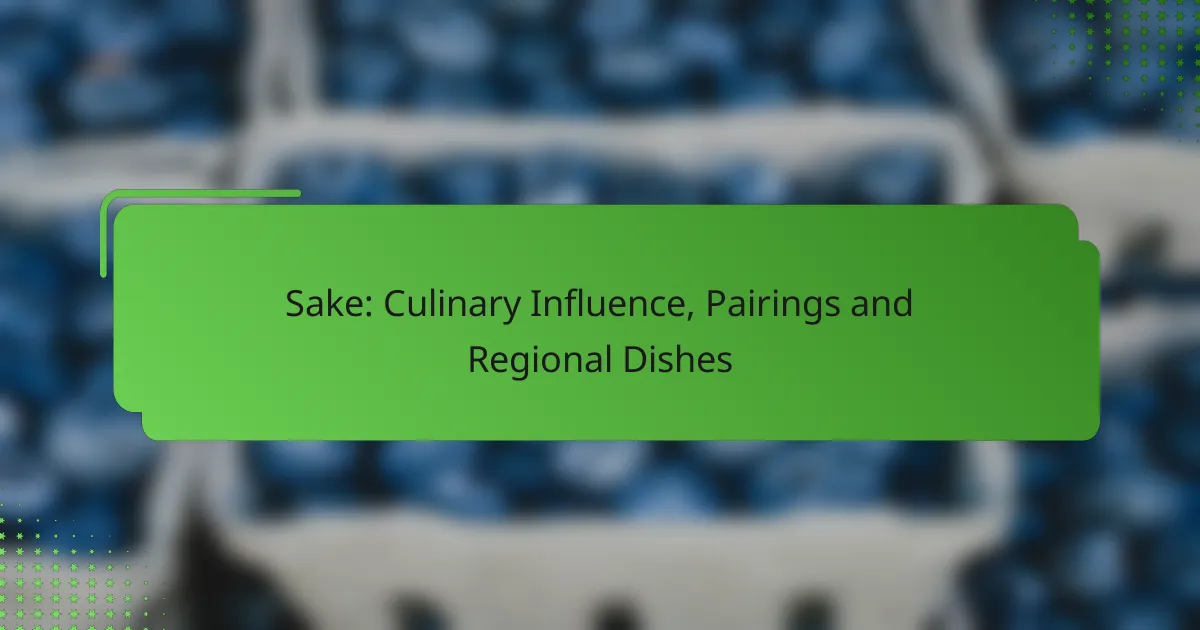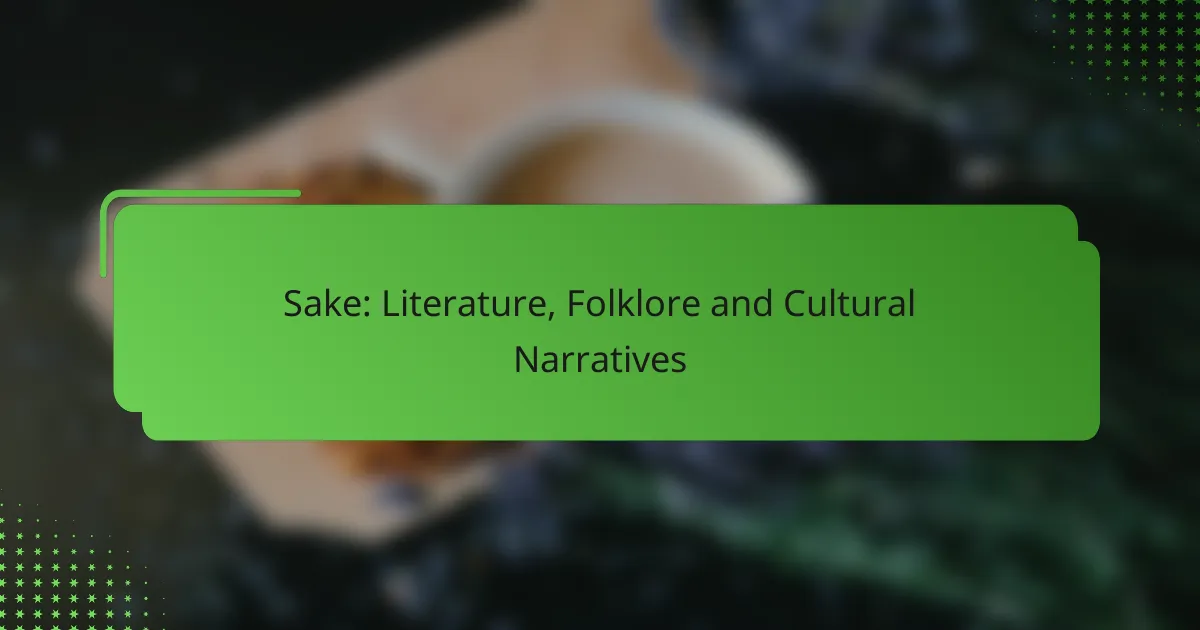Sake is more than just a beverage in Japan; it embodies the country’s rich cultural heritage and traditions. Throughout the year, various sake festivals celebrate this iconic drink, offering tastings, local food pairings, and cultural performances that highlight its significance in Japanese society. These events provide an immersive experience, showcasing the integral role of sake in rituals and community gatherings.

What are the major sake festivals in Japan?
Japan hosts numerous sake festivals throughout the year, celebrating the rich culture and tradition surrounding this iconic beverage. These festivals often feature tastings, local food pairings, and various cultural performances, providing an immersive experience for attendees.
Saijo Sake Matsuri
The Saijo Sake Matsuri, held in Hiroshima Prefecture, is one of Japan’s most famous sake festivals, typically taking place in October. Visitors can sample a wide variety of sake from local breweries, enjoy traditional music and dance performances, and participate in sake-related workshops.
This festival is particularly known for its vibrant atmosphere, with stalls offering food pairings that complement the different types of sake available. Attendees often appreciate the chance to meet brewers and learn about the sake-making process firsthand.
Fushimi Sake Matsuri
Fushimi Sake Matsuri occurs in Kyoto, celebrating the area’s rich sake brewing heritage. Usually held in the fall, this festival features tastings from numerous local breweries, showcasing the unique flavors of Fushimi sake, which is known for its purity and quality due to the region’s soft water.
In addition to tastings, the festival includes various cultural activities, such as traditional arts and crafts, making it a great opportunity to experience Kyoto’s culture alongside its sake.
Otaru Sake Festival
The Otaru Sake Festival takes place in Hokkaido, typically in February, and is known for its beautiful winter scenery. This festival features sake tastings from local breweries, alongside delicious Hokkaido cuisine, which is renowned for its fresh seafood.
Visitors can enjoy various events, including ice sculptures and live music, creating a festive atmosphere that highlights both the local culture and the enjoyment of sake during the winter months.
Niigata Sake Festival
Niigata Sake Festival is held in Niigata Prefecture, a region famous for its high-quality sake production. This festival usually occurs in the fall and features tastings from over a hundred local breweries, allowing attendees to explore the diverse flavors of Niigata sake.
The event often includes food stalls offering local delicacies that pair well with sake, as well as cultural performances that showcase the region’s traditions, making it a comprehensive cultural experience.
Tokyo Sake Festival
The Tokyo Sake Festival, typically held in the spring, brings together a wide range of sake producers from across Japan. This festival is ideal for those looking to sample various sake styles in one location, with many breweries presenting their best offerings.
In addition to tastings, the festival features educational seminars on sake tasting techniques and food pairings, making it a valuable experience for both novices and seasoned sake enthusiasts.
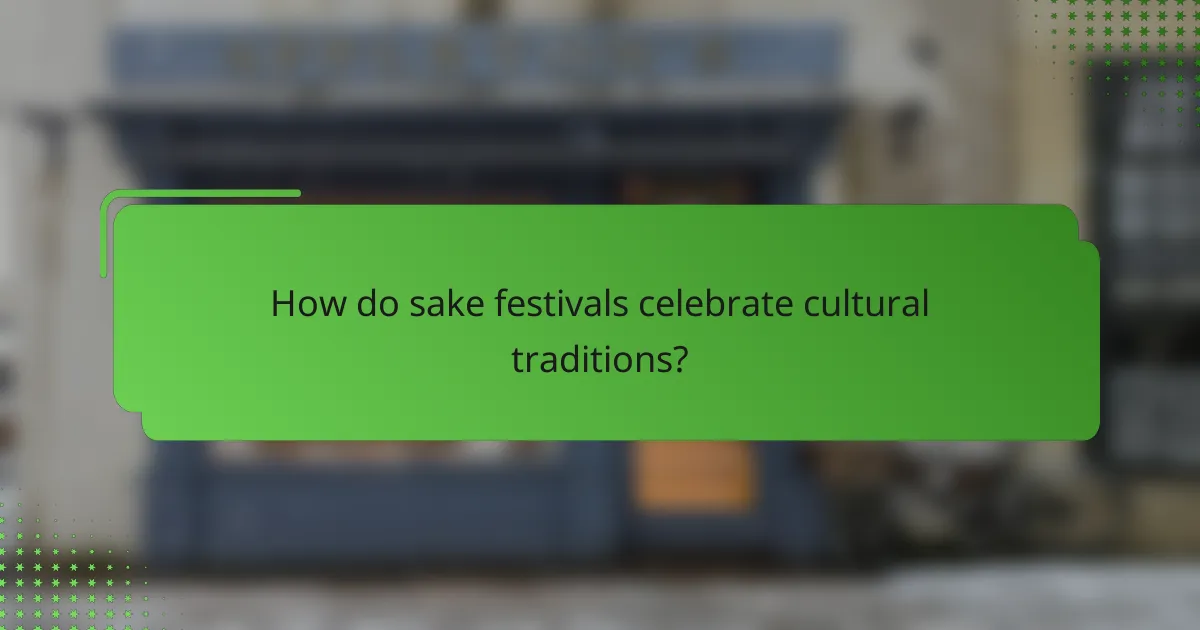
How do sake festivals celebrate cultural traditions?
Sake festivals celebrate cultural traditions by showcasing the rich heritage of sake brewing and its significance in Japanese society. These events often feature a blend of tasting experiences, cultural performances, and culinary pairings that highlight the integral role of sake in Japanese culture.
Traditional sake tasting events
Traditional sake tasting events are central to sake festivals, allowing attendees to sample a variety of sake types, including junmai, ginjo, and daiginjo. These tastings often take place in designated areas where brewers present their products, providing insights into the brewing process and flavor profiles.
Visitors typically receive tasting cups and can purchase tokens for sampling different sake varieties. It’s common to find local breweries showcasing their best offerings, which fosters a sense of community and appreciation for regional craftsmanship.
Cultural performances and rituals
Cultural performances and rituals at sake festivals enhance the celebratory atmosphere, often featuring traditional music, dance, and ceremonial practices. These performances may include taiko drumming, folk dances, and even sake pouring ceremonies, which symbolize hospitality and respect.
Rituals such as the “shinto purification” ceremony are also common, where sake is offered to deities, reflecting the spiritual connection between sake and Japanese culture. These elements not only entertain but also educate attendees about the historical significance of sake in Japanese traditions.
Food pairings with sake
Food pairings with sake are an essential aspect of festivals, as they highlight how sake complements various Japanese dishes. Common pairings include sushi, sashimi, and grilled meats, which enhance the tasting experience and showcase the versatility of sake.
Many festivals feature food stalls offering a range of local delicacies that pair well with different sake types. Attendees are encouraged to experiment with flavors, discovering how the umami in food interacts with the acidity and sweetness of sake, creating a harmonious dining experience.
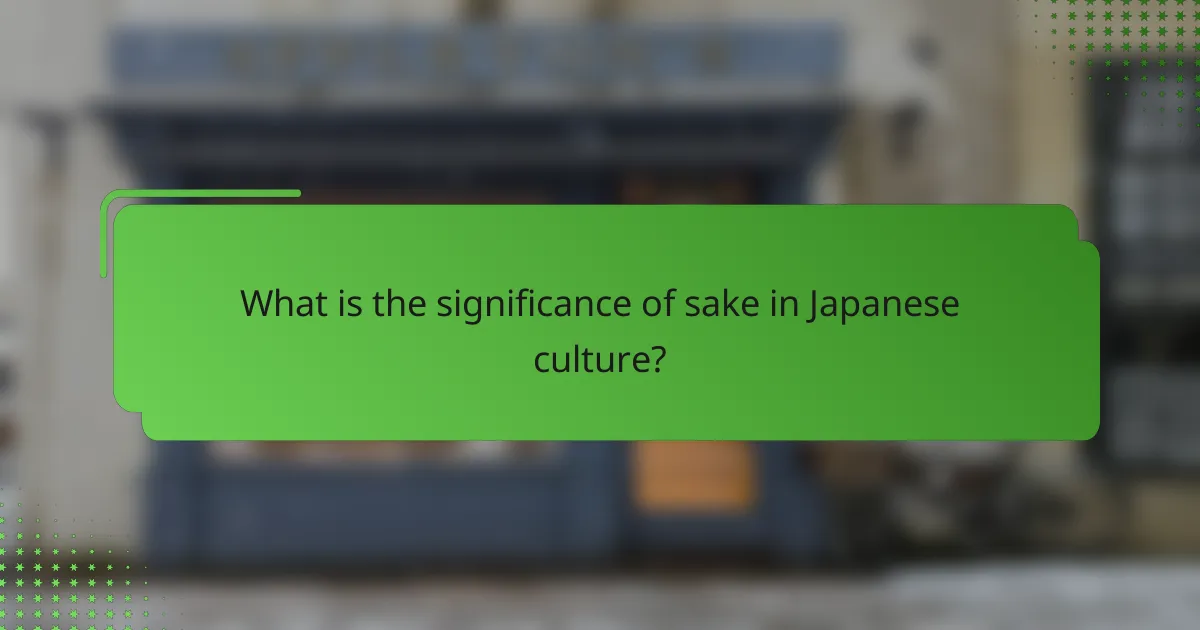
What is the significance of sake in Japanese culture?
Sake holds a vital place in Japanese culture, symbolizing purity, celebration, and community. It is not only a traditional beverage but also a key element in rituals and social gatherings, reflecting the deep-rooted customs of Japan.
Sake as a ceremonial beverage
Sake is often used in various ceremonies, including weddings and religious rituals, where it represents a connection between the divine and the human. The act of sharing sake, known as “sakazuki,” is a significant gesture that fosters unity and trust among participants.
During Shinto rituals, sake is offered to deities as a form of respect and gratitude, highlighting its role as a sacred drink. This ceremonial use reinforces the beverage’s importance in spiritual practices and cultural heritage.
Role of sake in festivals and celebrations
Sake plays a central role in many Japanese festivals, known as “matsuri,” where it is consumed to enhance the festive atmosphere. Events like the famous cherry blossom festivals often feature sake as a way to celebrate the beauty of nature and the changing seasons.
In addition to local festivals, sake is commonly served during New Year celebrations, where it symbolizes renewal and good fortune. The tradition of “toso,” drinking special sake for health, is a common practice during this time.
Sake’s historical importance in Japan
The history of sake dates back over a thousand years, making it an integral part of Japan’s cultural evolution. Originally used for religious ceremonies, it gradually became a popular beverage among the general populace, influencing social customs and culinary practices.
Throughout history, sake production techniques have evolved, reflecting advancements in agriculture and brewing methods. This evolution has led to a diverse range of sake types, each with unique flavors and characteristics, showcasing the craftsmanship behind this traditional drink.

How to choose the right sake for festivals?
Choosing the right sake for festivals involves considering the occasion, the food pairings, and the preferences of your guests. Opt for a sake that complements the festival’s theme and enhances the overall experience.
Types of sake to consider
There are several types of sake to consider for festivals, including Junmai, Ginjo, and Daiginjo. Junmai is pure rice sake with a robust flavor, while Ginjo and Daiginjo are more refined, offering fruity and floral notes. For festive occasions, a sparkling sake or a flavored variant can add a fun twist.
Consider serving both chilled and warm sake, as temperature can significantly affect flavor. Chilled sake often highlights its crispness, while warm sake can enhance its richness.
Flavor profiles and pairings
When selecting sake, think about its flavor profile and how it pairs with food. Junmai sake pairs well with hearty dishes like grilled meats, while Ginjo complements lighter fare such as sushi and sashimi. Daiginjo, with its delicate flavors, is ideal for more refined dishes.
For a festival, consider offering a variety of sake options to cater to different tastes. This allows guests to explore and find their preferred pairings, enhancing their overall enjoyment.
Regional sake recommendations
Japan has several renowned sake-producing regions, each with unique characteristics. For example, sake from Niigata is known for its clean and crisp taste, while sake from Hyogo often has a rich and complex flavor profile. If you’re in the U.S., look for local breweries that may offer craft sake with regional influences.
When choosing regional sake, consider the festival’s theme or location. Supporting local producers can also add a special touch to your celebration, making it more memorable for attendees.

What are the best sake brands for cultural events?
Some of the best sake brands for cultural events include Dassai, Hakkaisan, and Nigori. These brands are renowned for their quality and unique flavors, making them ideal choices for celebrations and traditional gatherings.
Dassai
Dassai is celebrated for its premium Junmai Daiginjo sake, which is often regarded as one of the finest in Japan. Its smooth, fruity flavor profile makes it a popular choice for formal occasions and cultural events.
When selecting Dassai, consider the specific label; for instance, Dassai 23 is known for its delicate taste and is often served chilled to enhance its aromatic qualities. This brand pairs well with a variety of Japanese dishes, making it versatile for different cultural settings.
Hakkaisan
Hakkaisan offers a range of sake that embodies the essence of Niigata’s pristine water and rice. Its Junmai Ginjo and Junmai varieties are particularly well-suited for cultural events, providing a clean and crisp taste that appeals to many palates.
This brand is often enjoyed at festivals and ceremonies, where its balanced flavor complements traditional Japanese cuisine. Hakkaisan is also known for its commitment to quality, ensuring that each bottle reflects the craftsmanship of its brewers.
Nigori
Nigori sake, often referred to as “cloudy sake,” is unfiltered and has a unique, creamy texture. This style of sake is typically sweeter and fruitier, making it an excellent choice for those new to sake or for festive occasions.
When serving Nigori at cultural events, consider pairing it with desserts or spicy dishes to balance its sweetness. Its distinctive appearance and flavor can add a fun element to celebrations, making it a crowd-pleaser.






